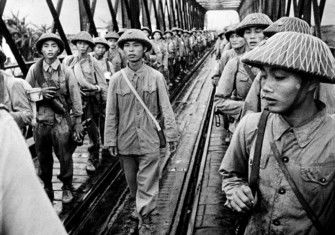Fight On
Why did Asia not have postwar peace?

The Second World War started in Asia in July 1937 when the Japanese invaded China; it ended there almost a decade later when Japan formally surrendered to the Americans on the USS Missouri in Tokyo Bay in September 1945. During that time, Hitler set Europe ablaze when his troops poured into Poland in 1939. And, of course, when the Japanese attacked the Americans in the Pacific Ocean in 1941 and then struck southwards into Southeast Asia to overturn one Euro-American empire after the other, the war became a truly global conflagration. The US would cross the Atlantic and the Pacific oceans to attack the Axis from both sides of Eurasia.
Much ink has rightly been spilled on what happened during the Second World War, but in many ways, as Ronald Spector demonstrates in this excellent book, the fighting did not end in Asia in 1945. The ‘long peace’ the Atlantic world and even the Soviet Union and its European satellites enjoyed during much of the second half of the 20th century had no such equivalent on the eastern side of Eurasia, where a variety of new conflicts broke out immediately after 1945. Take the example of Vietnam: on the very day General Douglas MacArthur accepted the Japanese surrender, the new Vietnamese president, Ho Chi Minh, stood before tens of thousands of his compatriots in Hanoi to declare Vietnam’s independence from almost a century of French colonial rule. Having recently been liberated from German occupation by the Allies, France’s new national leader, Charles de Gaulle, would have nothing of it: Indochina – Vietnam, Laos and Cambodia – was French and had to remain so. Within two weeks, a war of colonial conquest broke out between the French and the Vietnamese that would not end until Ho’s army brought down the French in a set-piece battle at Dien Bien Phu ten years later. Meanwhile, like the French, the Dutch went to war against the Indonesians who, like the Vietnamese, had dared to declare their country independent.
Decolonisation is one reason for the eruption of violence across the Asian continent. The outbreak of civil wars from the ruins of the Second World War was another historical phenomenon that contributed to the instability of the region, as local actors sought to take advantage of the changes in the balance of power on the ground to build new postcolonial states to their liking. Ho Chi Minh and his Communist Party may have defeated the French at Dien Bien Phu, but they also attacked non-communist nationalists who had rejected their right to rule an independent – communist – Vietnam. If the communists dominated their Vietnamese adversaries during the First Indochina War, in Indonesia a series of violent civil clashes saw the non-communist Republicans led by Sukarno vanquish their communist competitors. The Chinese civil war is another example that Spector analyses: civil and national wars of liberation continued across Asia beyond 1945, something that Europe did not encounter (with the important exception of Greece).
The Cold War did much to spread violence across the Asian continent. The key moment was the victory of the Chinese communists over the nationalists in 1949, prompting American efforts to contain the potential Sino-Soviet threat to the region. Contesting ideologies were part of the problem. So were security concerns. The spectre of the Japanese march across the Pacific in 1941-42 was never far from American minds. But the same was true for Mao, who feared the possibility of another hostile invasion coming from the sea. Spector deftly shows how, between 1950 and 1954, the Americans and the Chinese clashed directly in Korea and indirectly in Vietnam, entangling their struggles for ideological influence and national security with the civil and colonial wars that had been brewing across the continent for years.
A Continent Erupts reveals how the complex interaction of these various conflicts explains why the Asian continent did not enjoy much peace in the decade following the Second World War. It certainly did not have peace in places like Ho Chi Minh’s Vietnam, where colonial, civil and cold wars combined in a deadly mix that killed perhaps as many as one million Vietnamese by 1954. Nothing of the kind occurred in postwar Europe during the second half of the 20th century.
A Continent Erupts: Decolonization, Civil War, and Massacre in Postwar Asia, 1945-1955
Ronald H. Spector
W.W. Norton 538pp £29.99
Buy from bookshop.org (affiliate link)
Christopher Goscha is Professor of International Relations at the Université du Québec à Montréal and author of The Road to Dien Bien Phu: A History of the First War for Vietnam (Princeton University Press, 2022).






